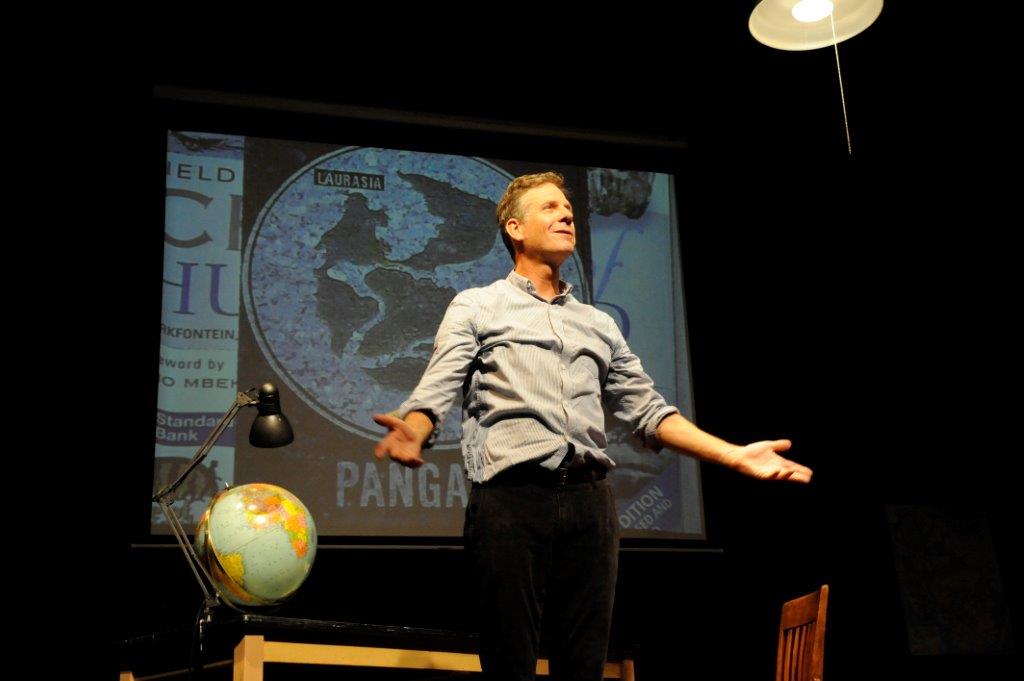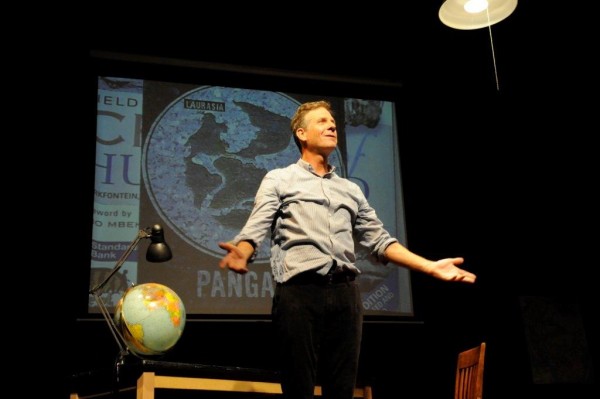
14 Sep Tall Tales: “All the Rage” at Denver’s Curious Theatre
Buy tickets for “All the Rage” at Denver’s Curious Theatre here.
Martin Moran’s opening at the beginning of “All the Rage” is the definition of casual. He strolls out the same way he might be dressed for a round of weekend errands. His shirt doesn’t fit quite right. He’s constantly readjusting the darn thing, trying to get it to stay tucked in. Unassuming? To say the least.
It’s just him, Martin Moran. One man on a stage and a few props—a globe, a couple of freestanding blackboards and a simple desk with one of those simple document projectors used by classroom teachers.
And there’s a backpack, soon to jettison all sorts of props and photos and maps.
Moran has a story to tell. He’s a Denver kid. He is best known for another solo show, “The Tricky Part,” about forgiveness. Moran might know a thing or two about that topic. He was sexually abused by a camp counselor when he was a young teenager (here in Colorado).
“All the Rage” is a bookend to the first—sparked by the question so frequently asked by others who heard or read the story (there’s a book now, too). Where was the anger? Wouldn’t he be angry? Shouldn’t you be angry?
On stage, Moran is Moran. He refers to the first play. He refers to his acting career, including a long stint in the Off-Broadway “Spamalot.” He refers to an encounter with a childhood friend that happened outside—right there—in the parking lot of the Curious Theatre when he was in town performing “The Tricky Part.” The definition of theatre here is quite blurry—it’s just Martin Moran telling a story and every tiny scrap of information he relays seems so grounded in fact and detail that we certainly aren’t questioning the integrity of the narrator or the events being relayed. Story? Or fact? Do we really care? “All the Rage” is a Mobius strip of reality and story. Is there such a thing as non-fiction theatre?
While harrowing in spots, “All the Rage” skews funny. Moran is self-effacing and, at times, ebullient. He’s got some zinging one-liners and, even in the grim times, finds a joke. The stories start with an encounter between himself and his nemesis stepmother at his father’s funeral in Las Vegas. The tales fly off to South Africa and Manhattan and the Indian Peaks of Colorado. He insists on showing us maps or spots on the globe, to ground the moments on the face of the earth. Magnets snap onto the mounted map of New York City with authority—see, this happened right here.
“All the Rage” is masterfully written. Eighty minutes rocket along as Moran flies about the stage, connecting the dots of his personal experiences. He’s an actor excitedly revealing the distilled essence of his own inner self based on terribly human encounters—a fellow actor on the subway, an African refugee seeking asylum, an African guide who can’t read, his own (and much angrier) older brother. In the re-telling of how he helped the African refugee gain asylum, we learn that Moran speaks fluent French (and he re-enacts his role as interpreter in a few scenes). This “shared tongue” is the underlying point of Moran’s entire message.
Moran is, in fact, a good and experienced actor and the bits and moments give him every chance to display his acting chops, all while playing himself. To repeat—the definition of theater is taken for a ride.
Death is the play’s substrata. It lurks right around the corner, even with references to streets in New York City named after Peter Jennings or Leonard Bernstein. But you’d never know that based on the upbeat look on Moran’s face. He’s a searcher. He enjoys wondering. He concedes to the premise—where is the rage? He can conjure it up if he needs to—but does that really mean that it’s part of his true character, if he’s just acting?
Near the end of “All the Rage,” Moran relays a wacky dream seeded by nuggets and details from key incidents. It makes no sense, like most dreams, but gives Moran some middle-of-the-night peace that makes it okay for Martin Moran to be himself. Moran stands for the right, as a human being, to adopt his own code, to look for commonalities rather than differences. Moran stands for compassion and, in the end, you realize that compassion is what should be all the rage.
Editor’s note: Telluride Inside… and Out’s monthly (more or less) column, Tall Tales, is so named because contributor Mark Stevens is one long drink of water. He is also long on talent. Mark was raised in Massachusetts. He’s been a Coloradoan since 1980. He’s worked as a print reporter, national news television producer, and school district communicator. He’s now working in the new economy and listed under “s” for self-employed. Mark has published two Colorado-based mysteries, “Antler Dust” (2007) and “Buried by the Roan” (2011). Midnight Ink will publish the third book, “Trapline,” in the fall of 2014 and is under contract for a fourth book in the series, too. For more about Mark, check out his website.




Sorry, the comment form is closed at this time.